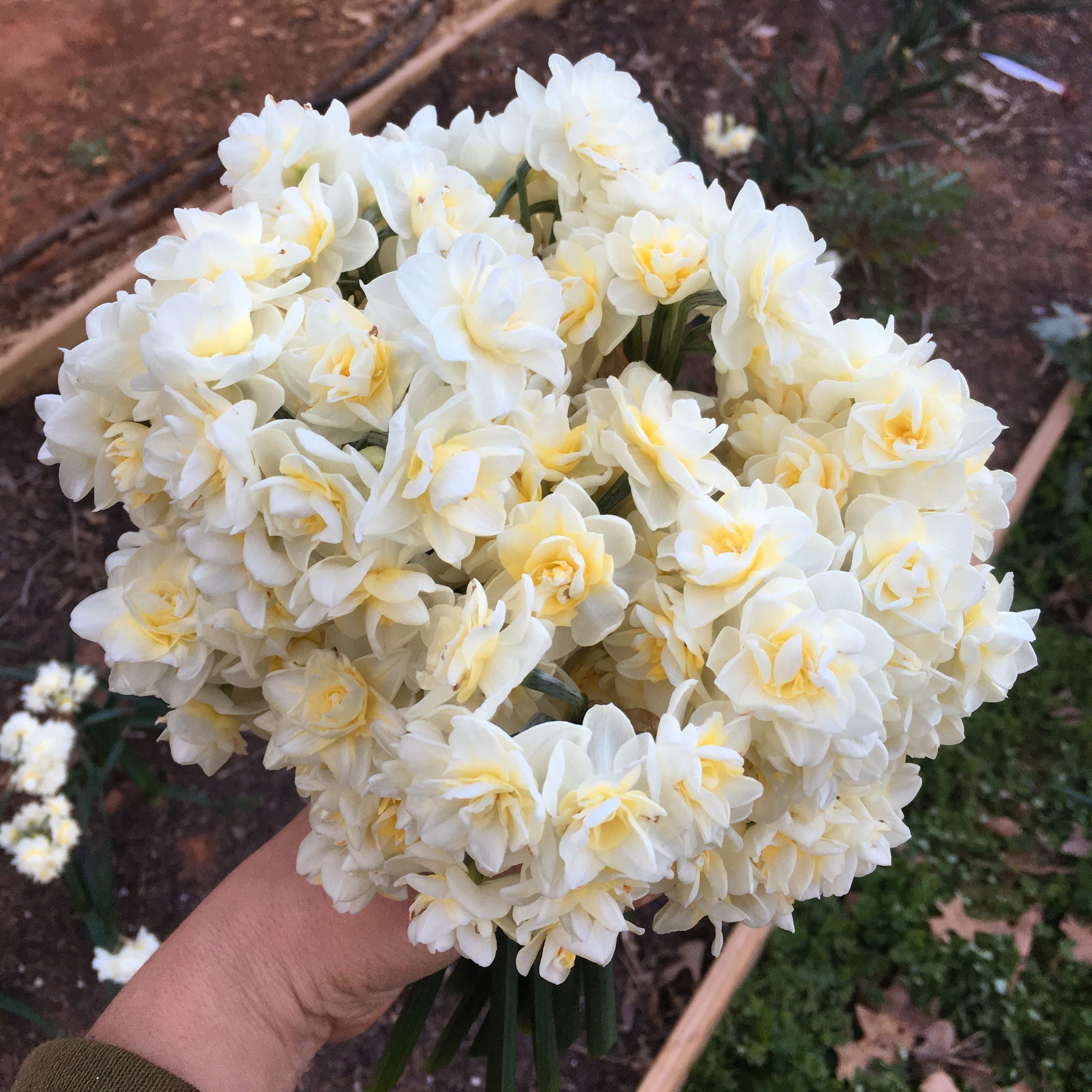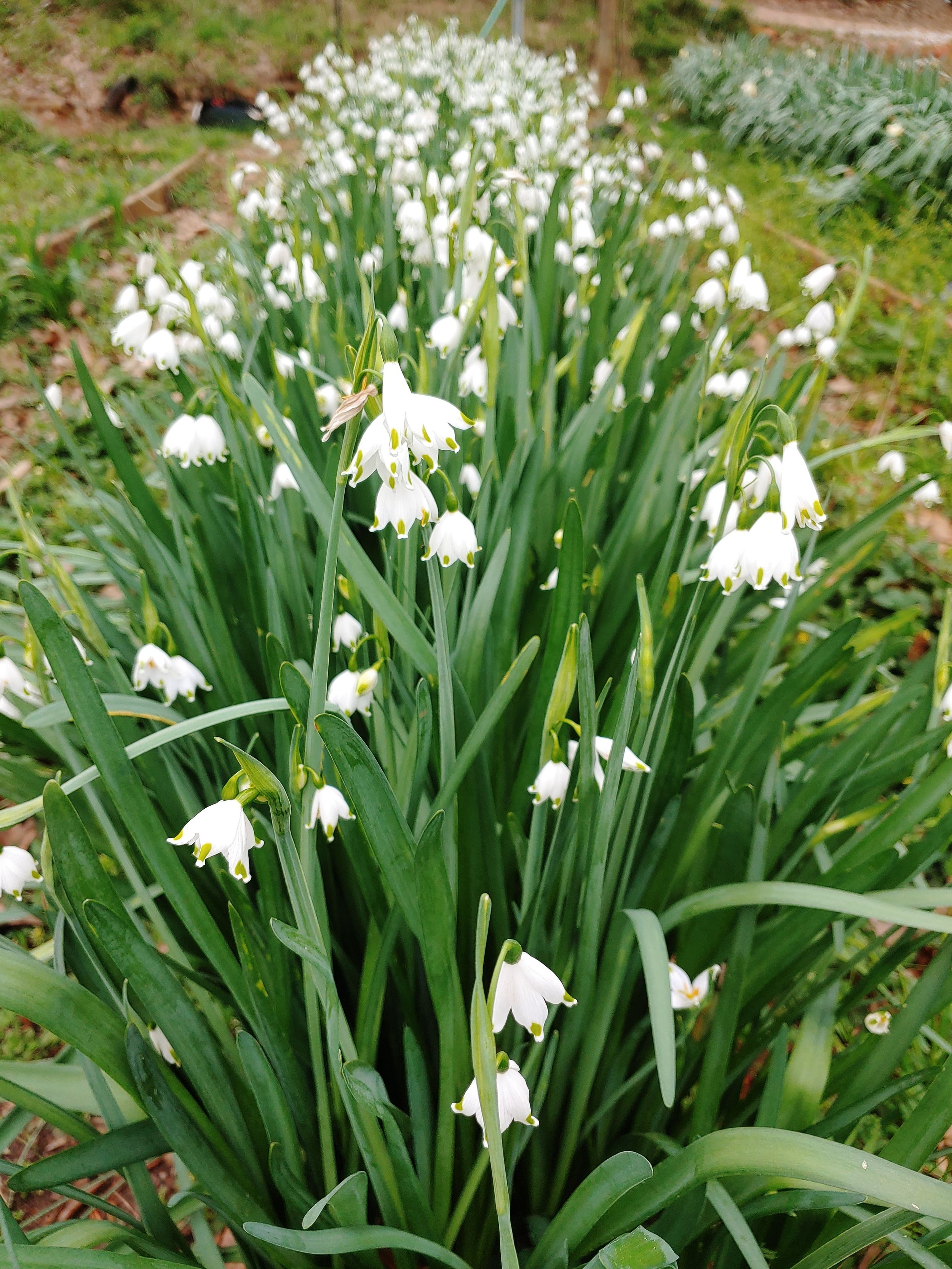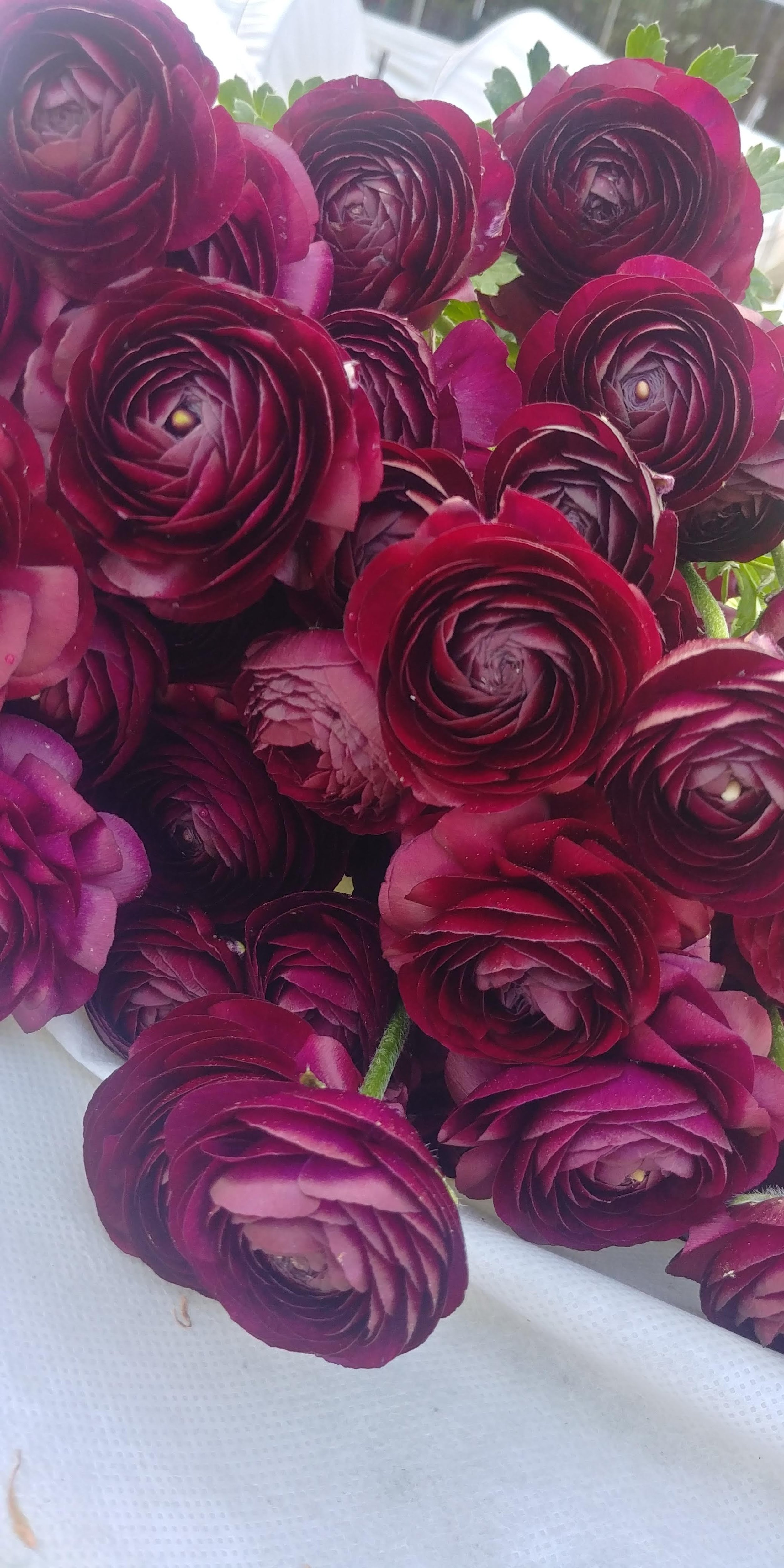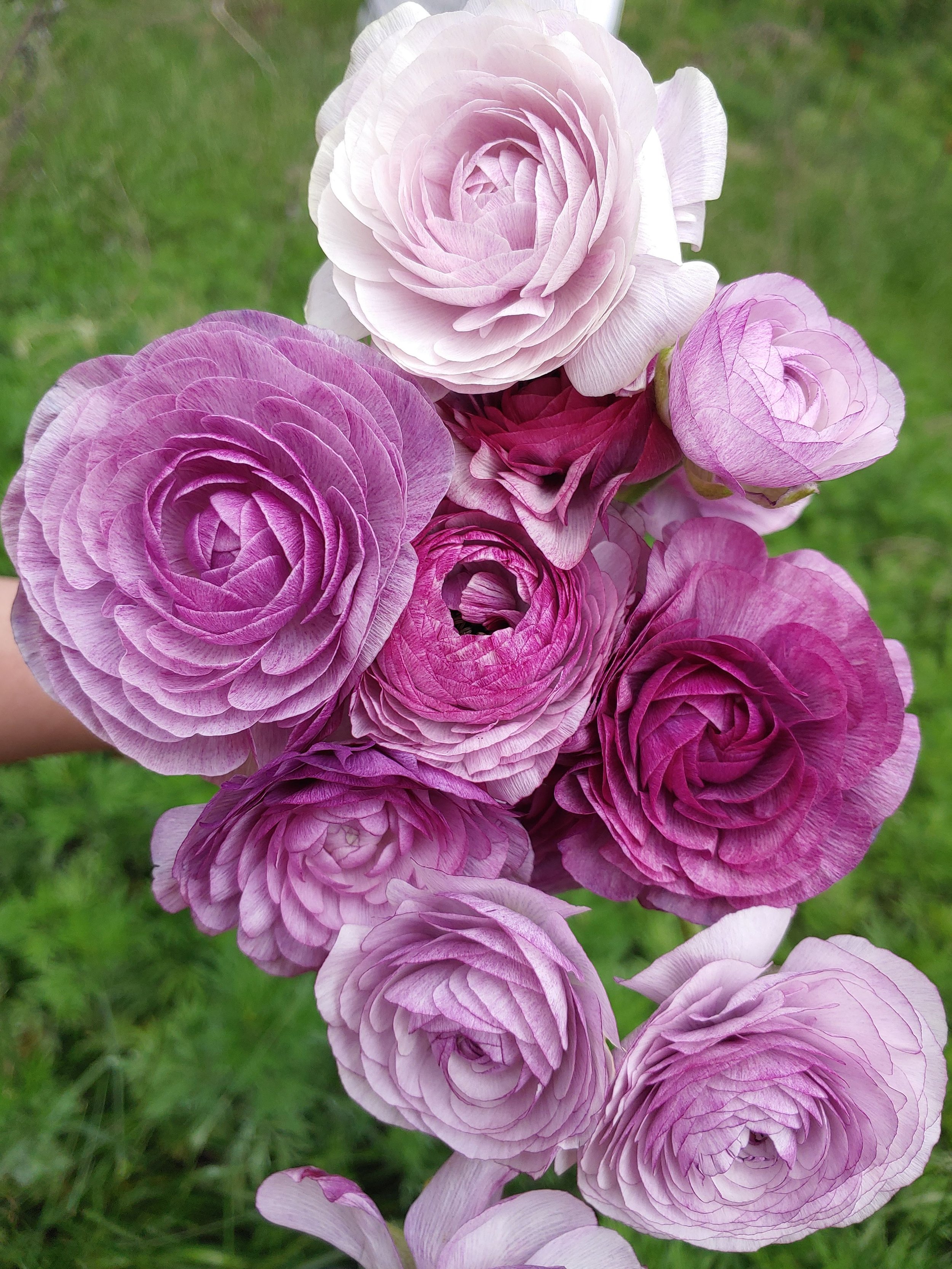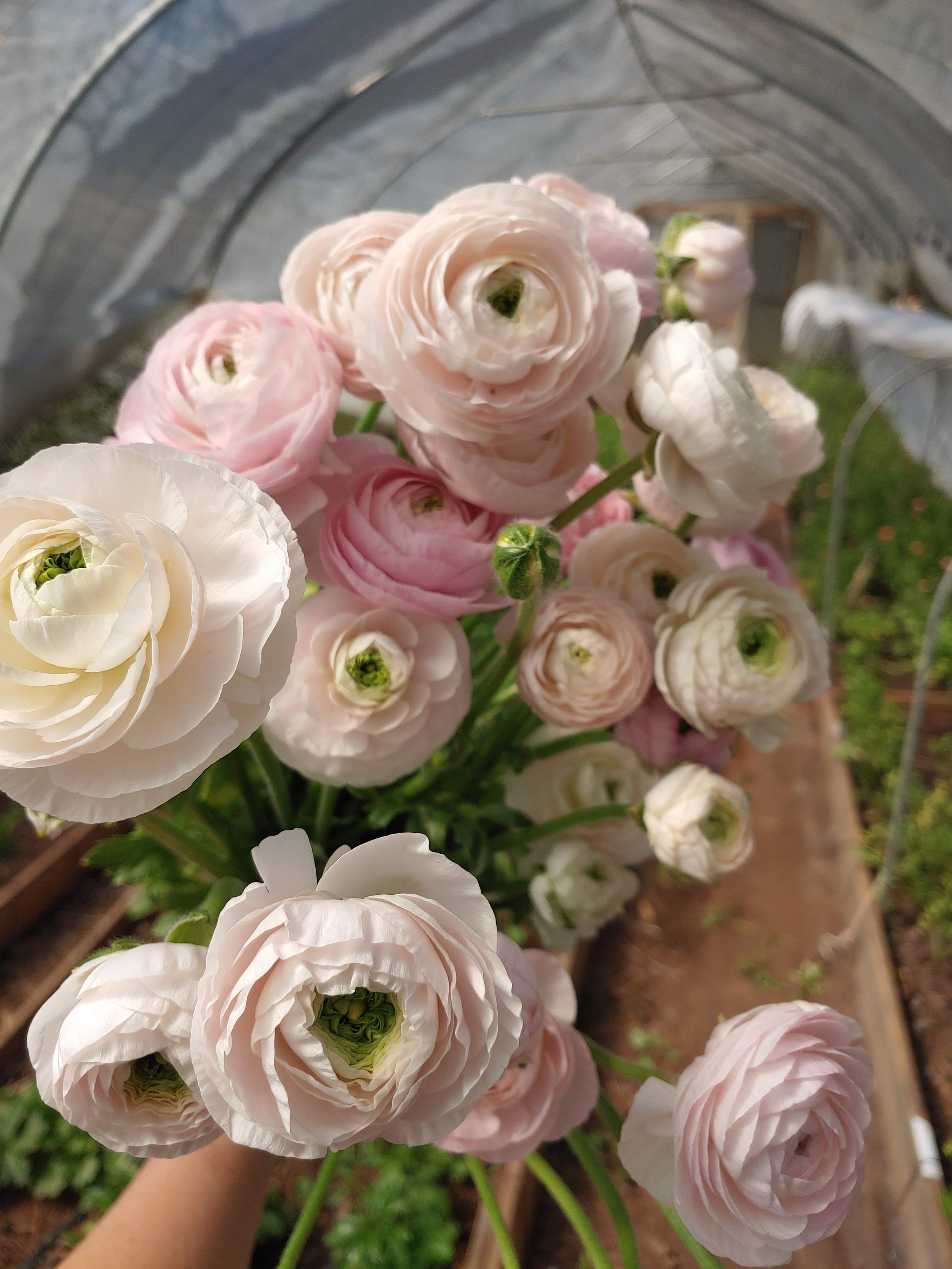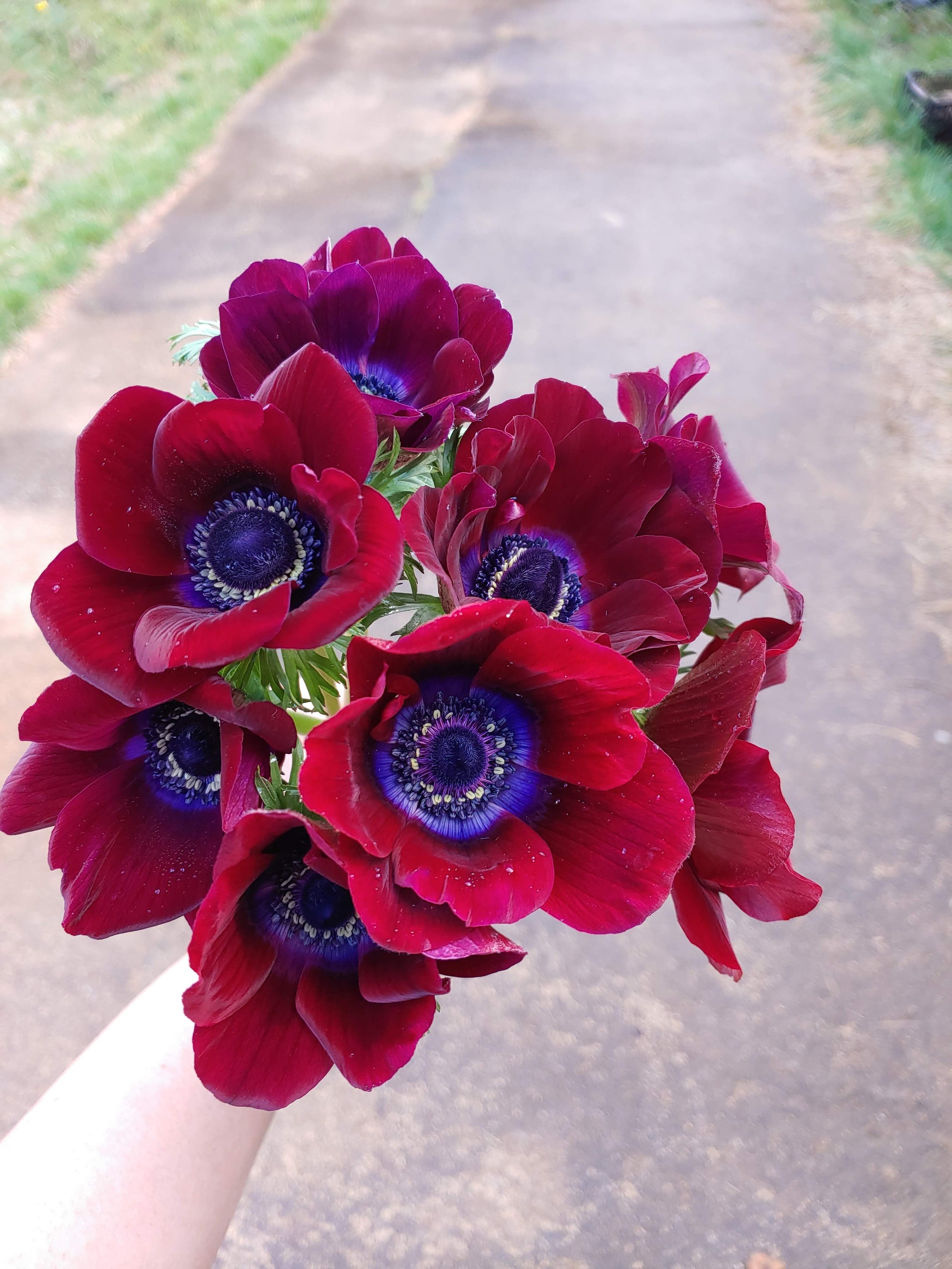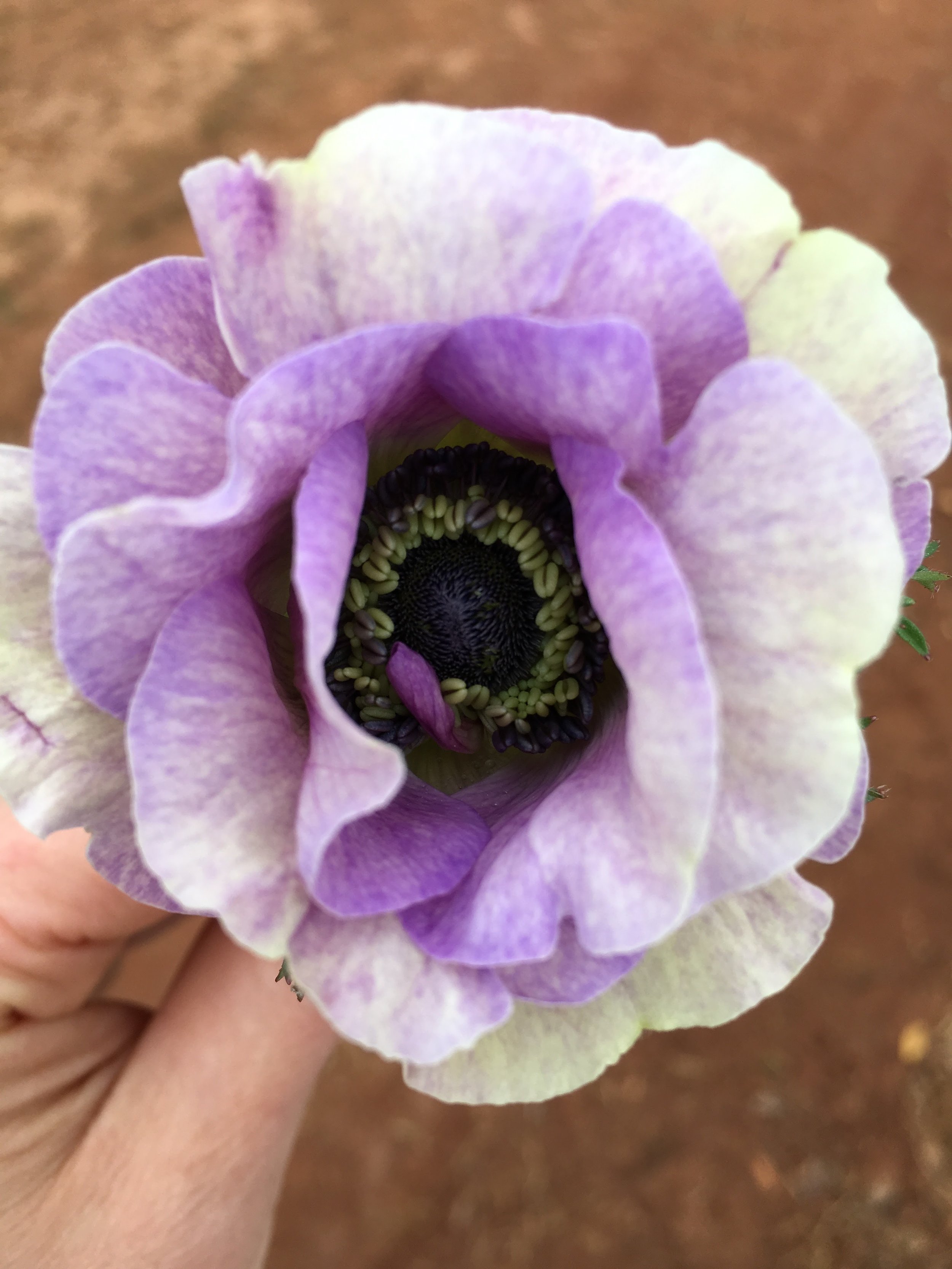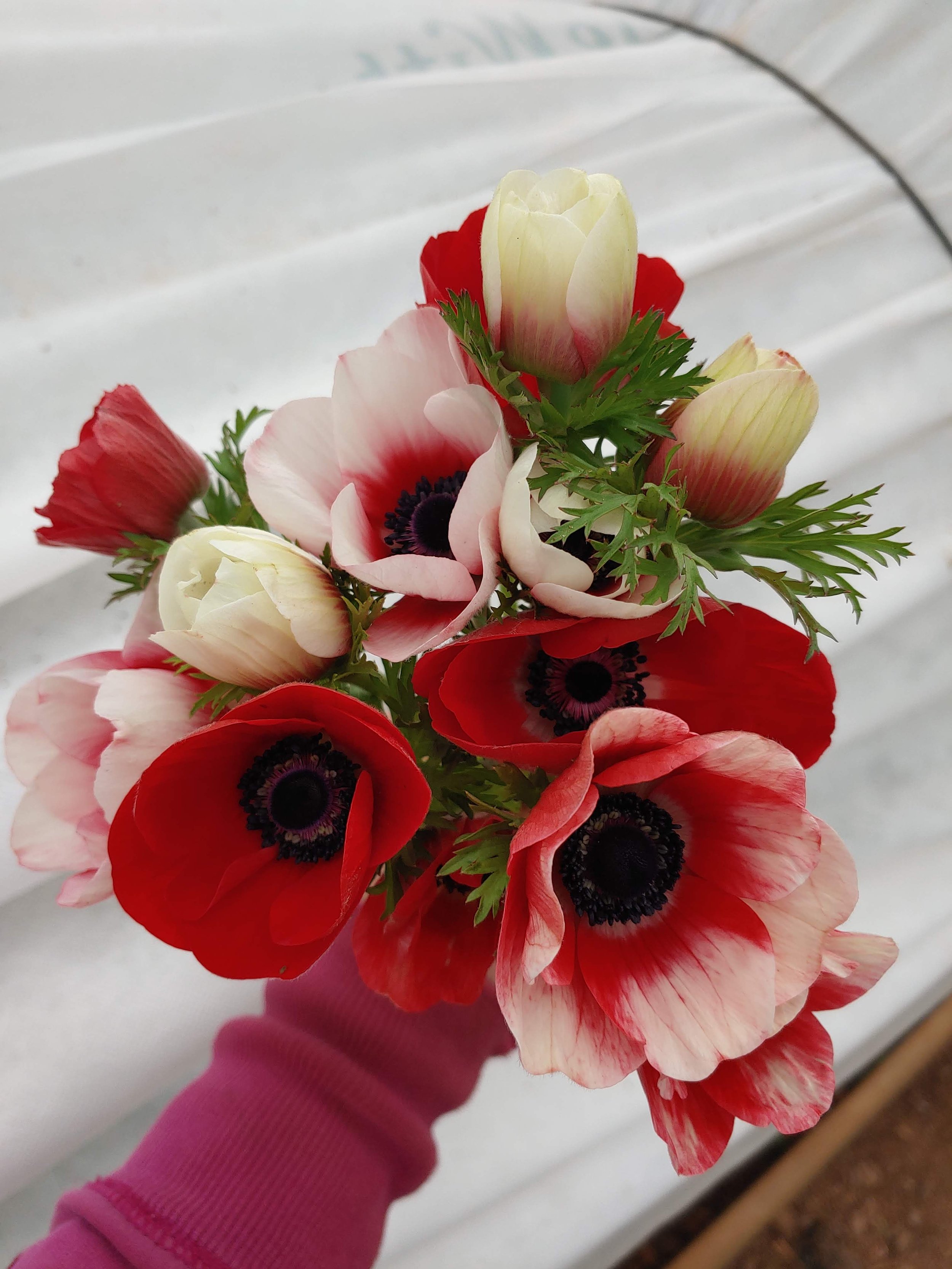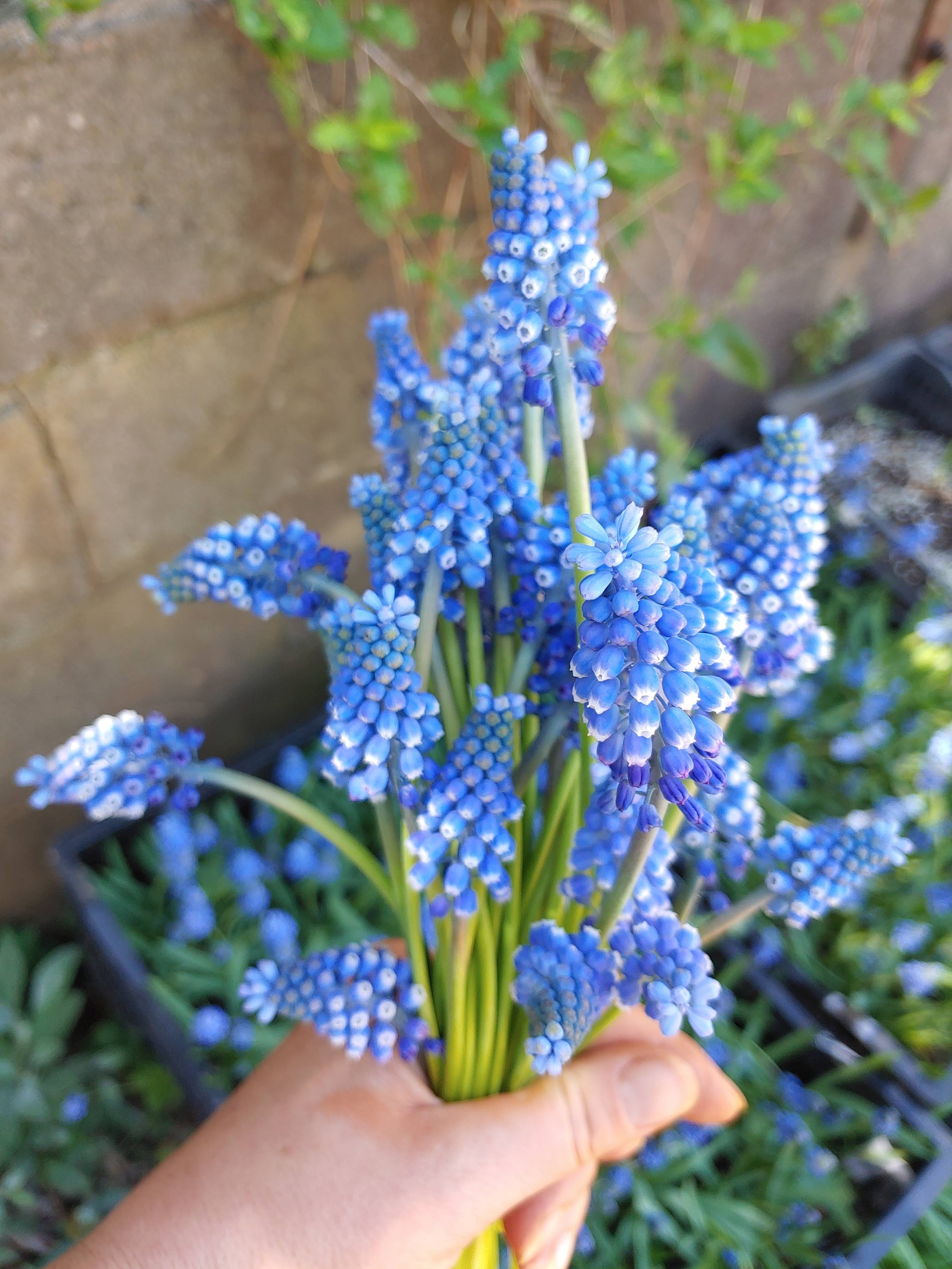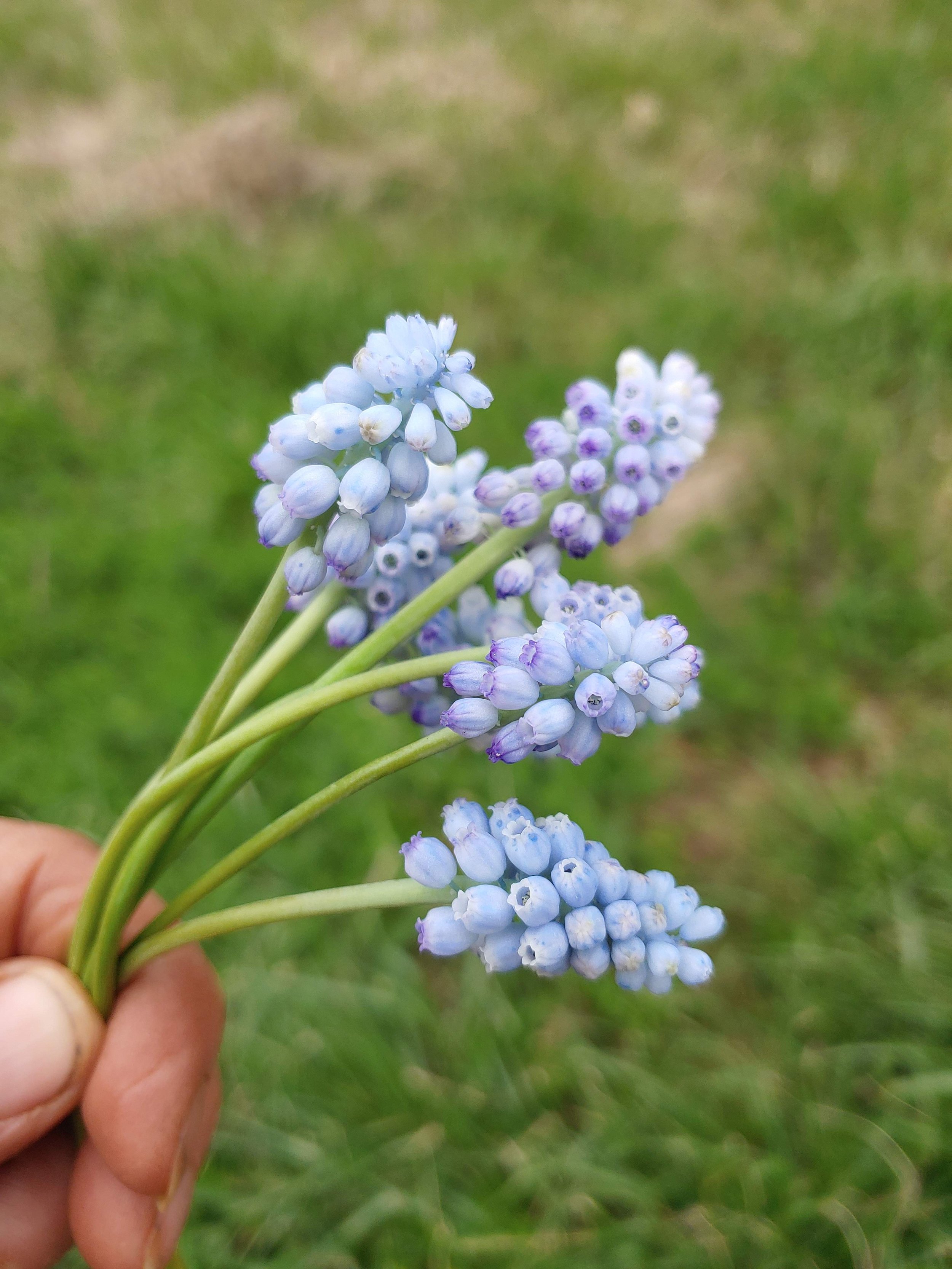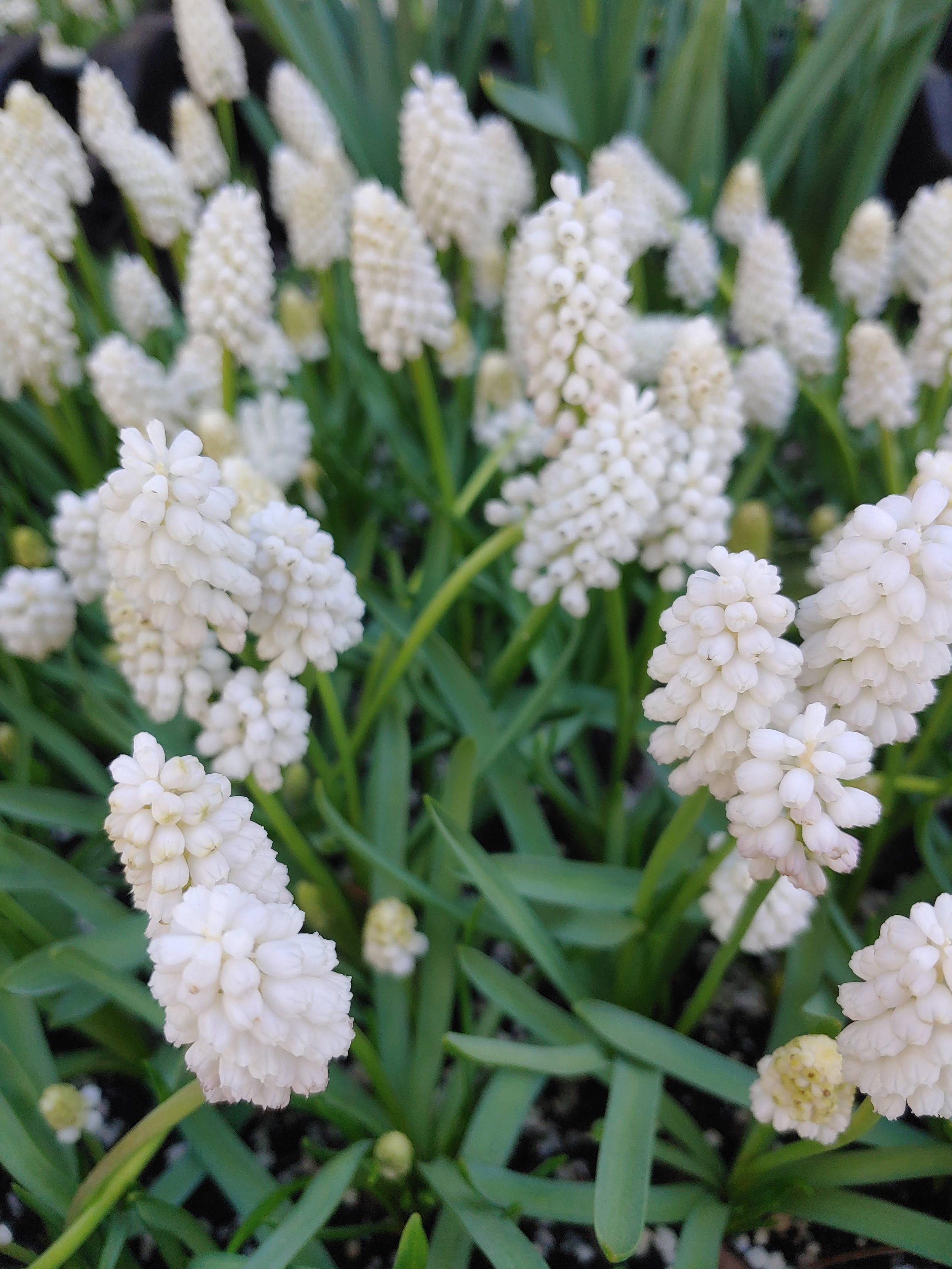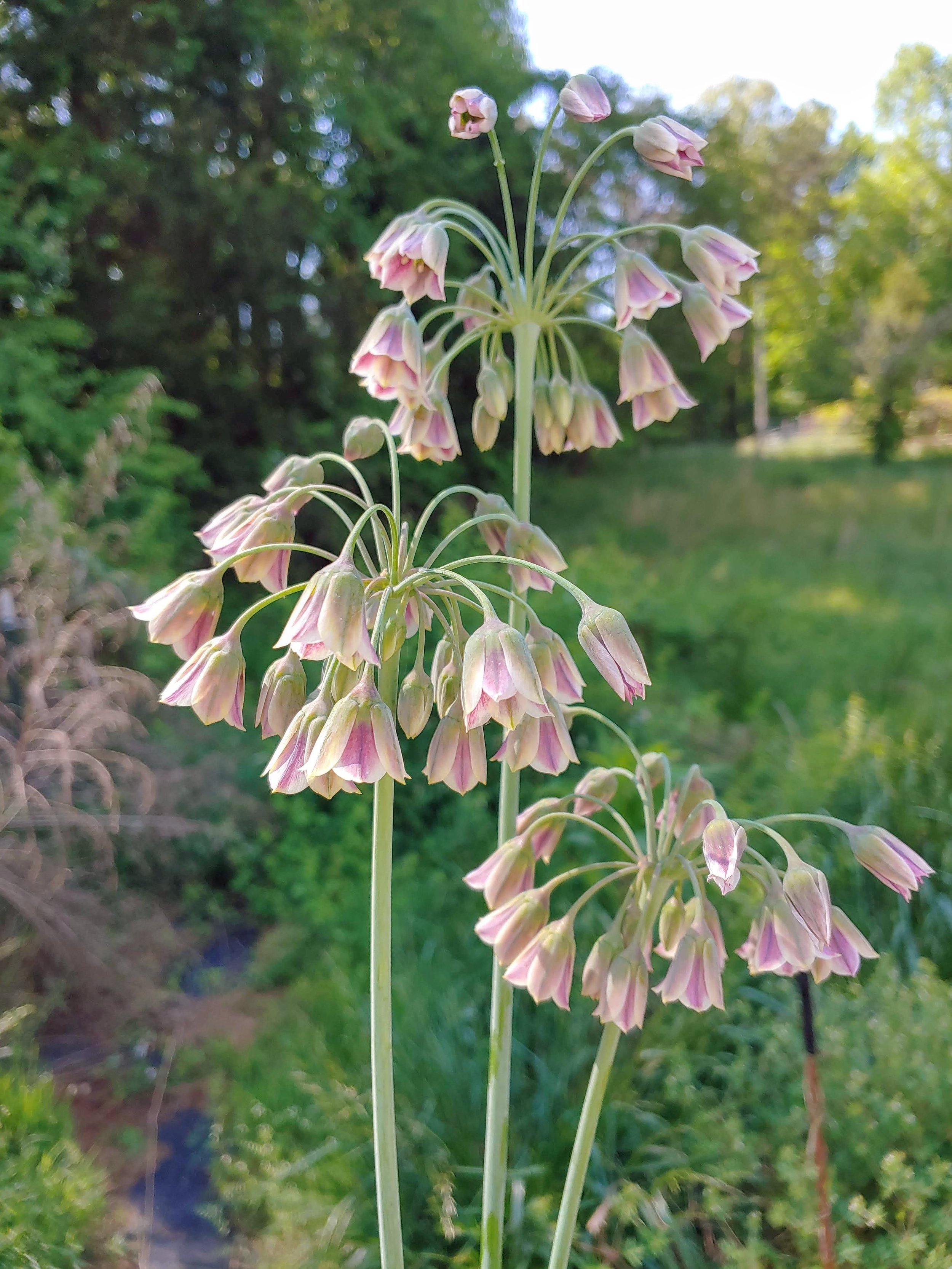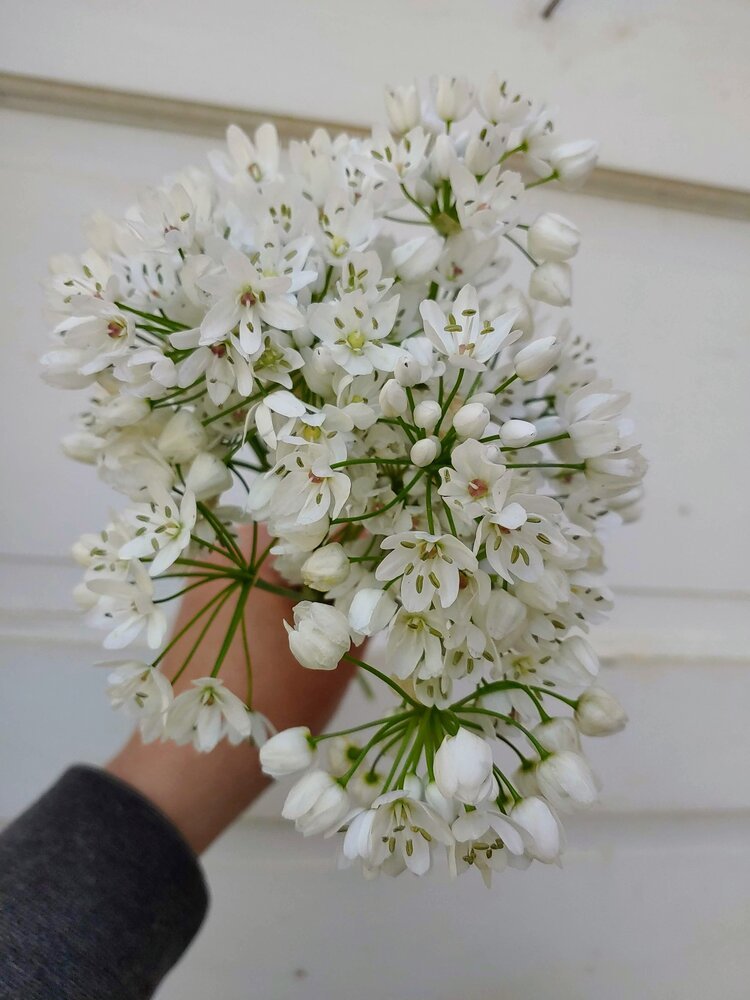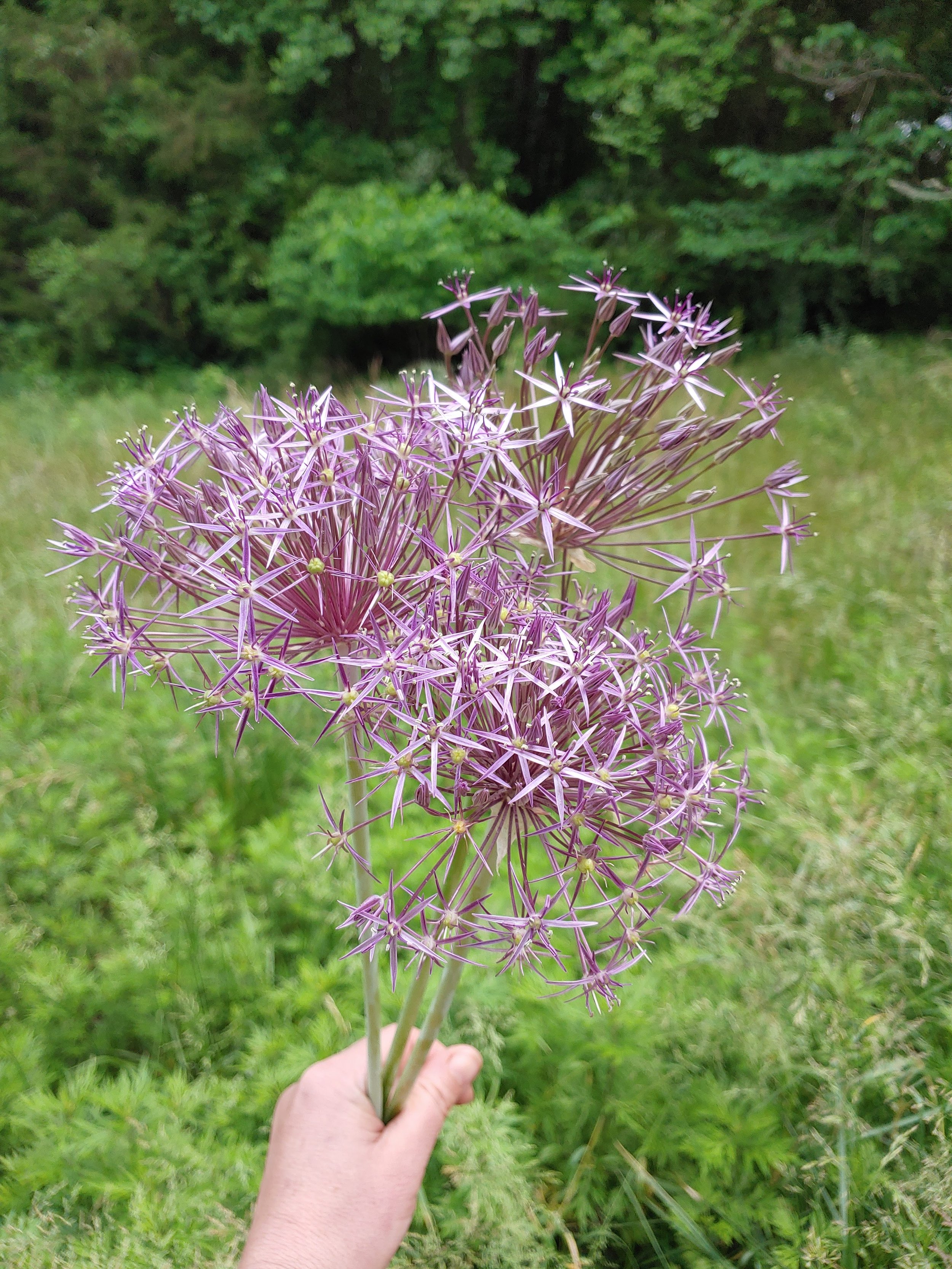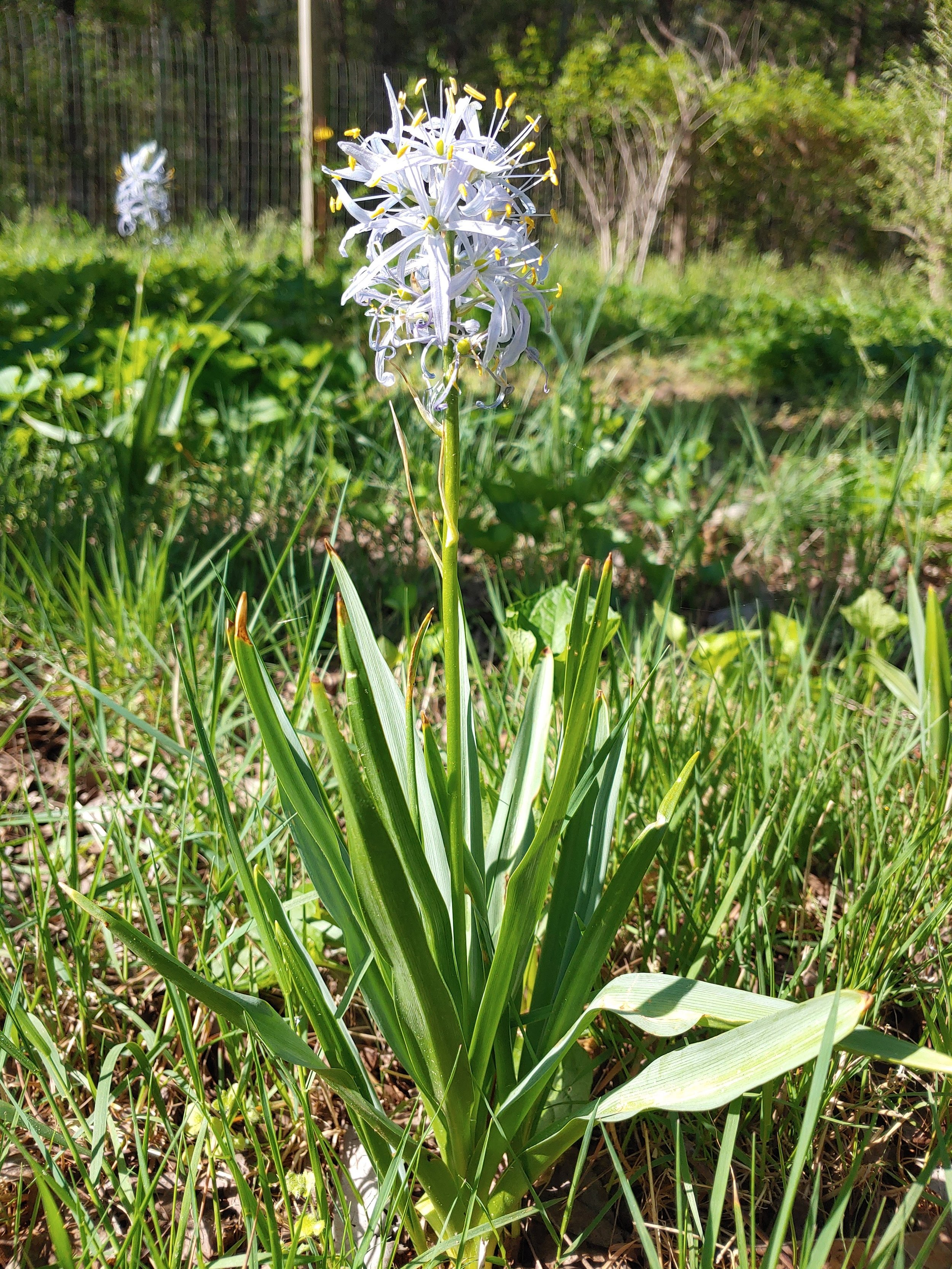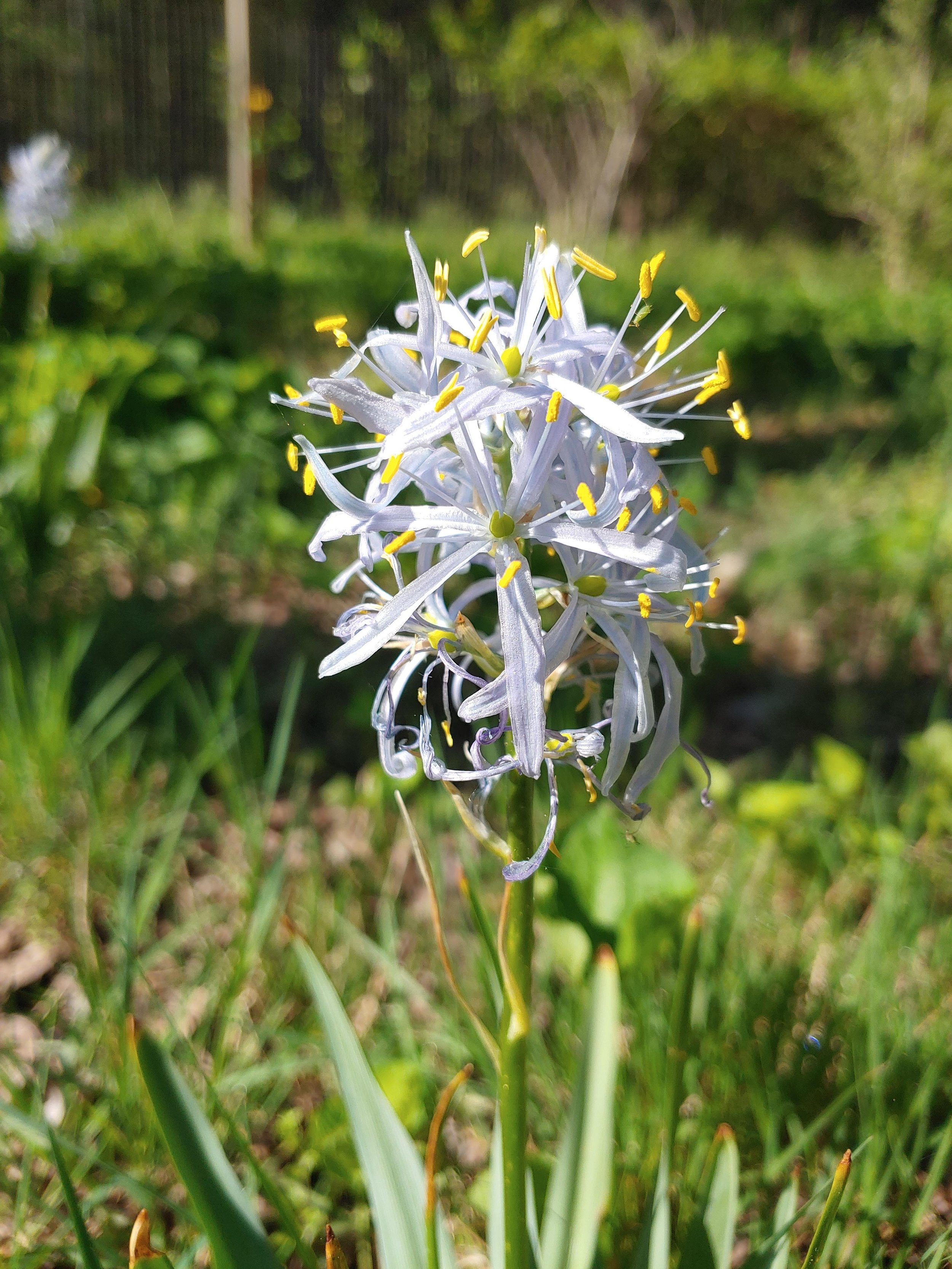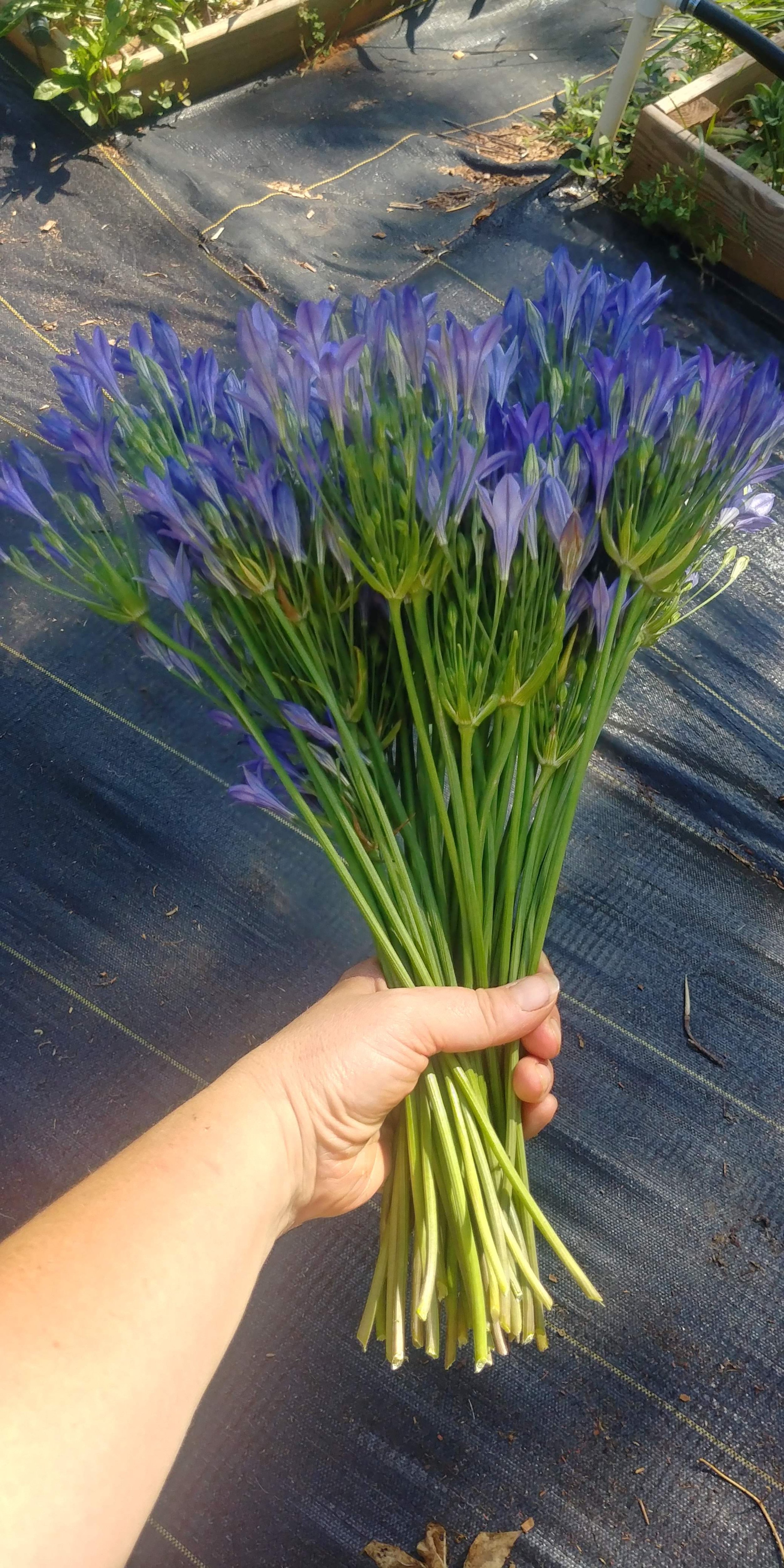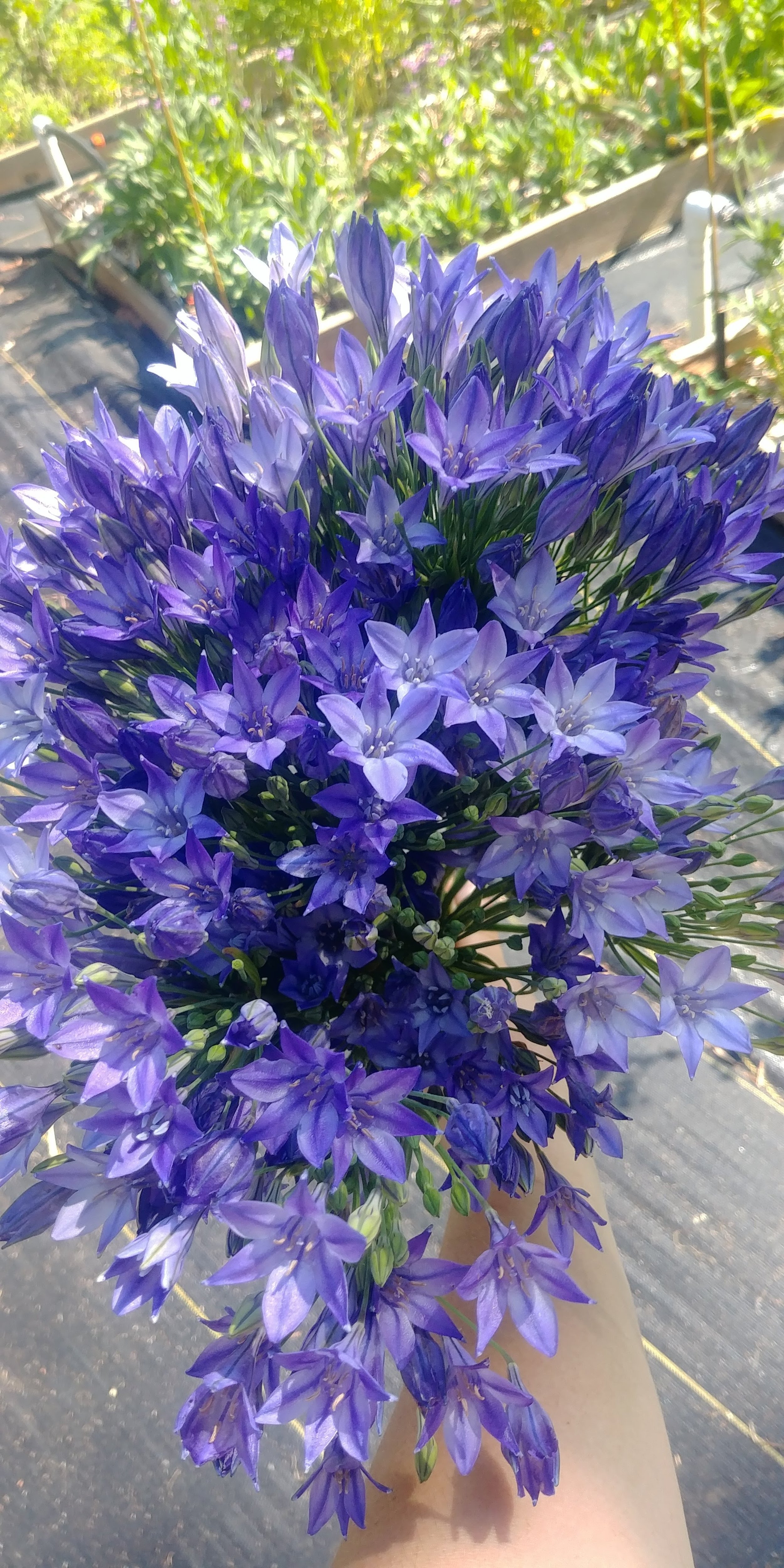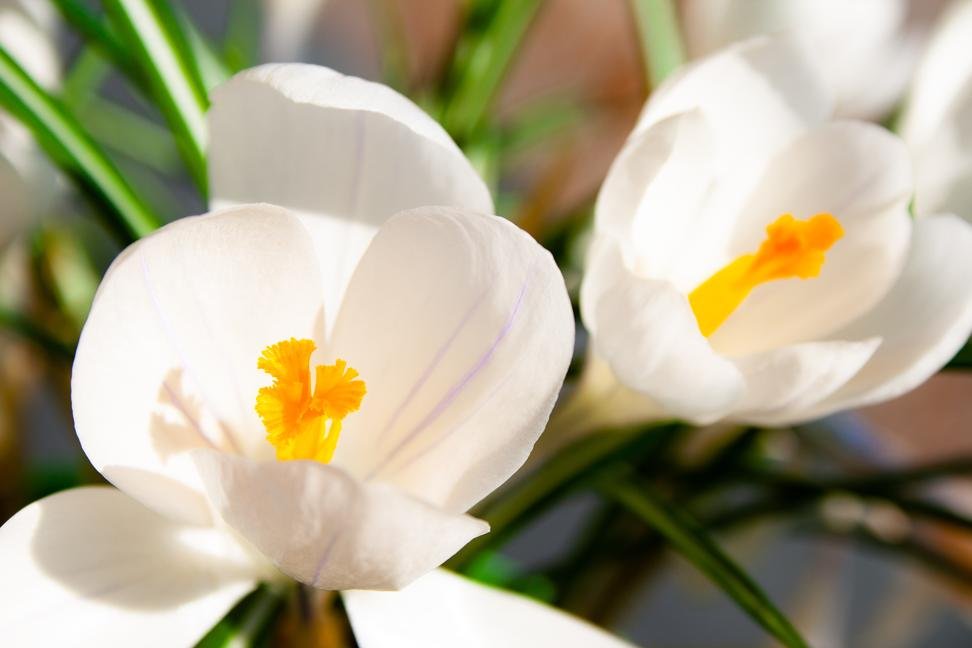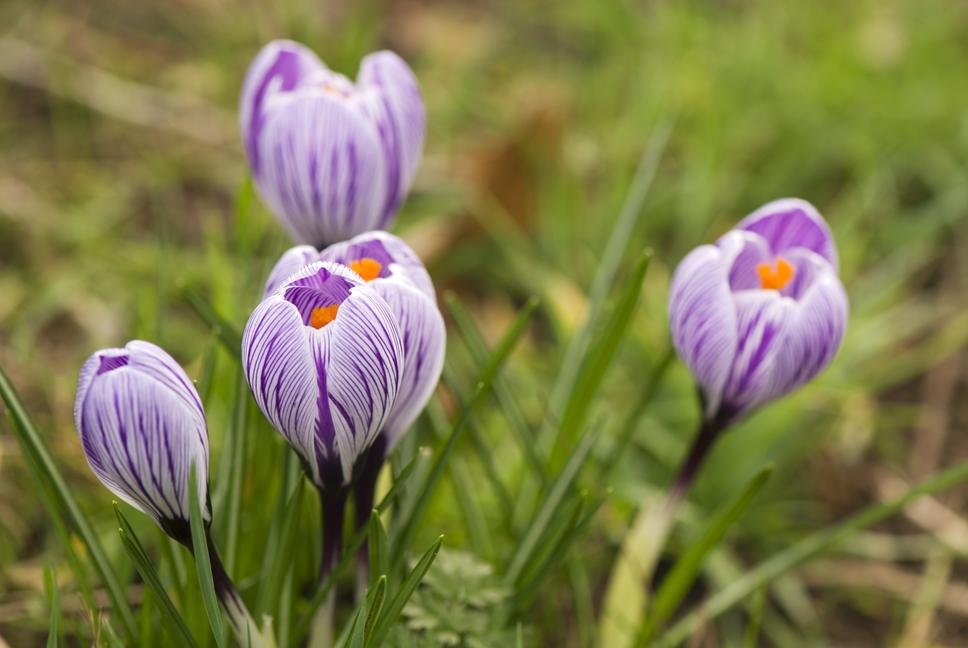
What to plant for a succession of Spring Blooming Bulbs
Planting bulbs is probably the easiest way to get a continuous succession of Spring blooms. It’s definitely one of those activities for which I thank myself later!
Over the years, I’ve observed and learned what blooms when and filled in the gaps so that I have a continuous supply of blooms from my bulbs. I grow in South Carolina, Zone 7b so my timing is based on that. If you are warmer, then back the timing up a few weeks to a month. If you are colder then push the timing forward and also realize that you may have some items that bloom more at the same time instead of in a long succession. The milder winters that warmer regions have can cause a longer periods of blooms. Also please keep in mind that yearly weather patterns can accelerate or delay blooms by a matter of several weeks sometimes.
So here’s how I have it planned out in my farm/garden. The season begins in late February to early March with early blooming Narcissus (Earlicheer). Narcissus are divided into early, mid and late types so you can plant all of them and get 6-8 weeks worth of blooms. Earlicheer is the earliest variety I have. White Lion is my next variety to come into bloom followed by Tahiti. Snowdrops bloom about the same time as mid season narcissus which is late March through early April in my area. The snowdrops make a beautiful addition to any narcissus bouquet.
Anemones come in early March most years, sometimes February if we are having a warm winter. Fritillaria Meleagris joins them in mid march. Ranunculus usually begin later March through early April and continue through Mother’s Day.
Muscari will join the bouquet in mid to late March.
Alliums are another bulb that can take you through several weeks. I usually have them in bloom for 4-5 weeks by planting different types. Cowanii is first, then Christophii and Sicilium followed by Unifolium. The super large ones (I don’t grow these) come in mid may from what I can tell. Alliums usually begin in mid April.
Camassia is one of the last to bloom in mid to late May. I always welcome their cute star shaped flowers. They don’t make the greatest cut flower but I like to grow them just for their presence and I love the soft blue color.
Tritellia is another late blooming bulb- late May to early June. It’s just harder to find. I tried to source it for this year’s bulb sale but was unable to get it. But if you can find it, it will complete a 5 month bulb succession. They come in blue, white and pink if you can find it.
Crocus are a new one for me this year. I’m adding them in to begin the flower show even earlier. I think they will beat the narcissus. So my hope is that from February to June, I can have an easy to grow bulb blooming in my garden.
So here’s the cheat sheet: In Bloom order—
1. Crocus
2. Narcissus, Anemones, and Ranunculus
3. Muscari and Fritillaria
4. Alliums
5. Camassia
6. Tritellia
** Most of these will come back year after year. I do plant my anemones and ranunculus as annuals though. You can try treating them as perennials but sometimes they do rot out during the summer. They are a good candidate for digging and storing however. If you are warmer than zone 8, I’d skip the later narcissus and alliums as they require longer cooling periods. It’s possible that even with the earlier varieties they may be more of an annual in a warm climate.
So what are you waiting for? Go make your wishlist from our Fall Bulb Sale! Here’s to a beautiful Spring filled with blooms!!
How to Grow a Beautiful Spring Garden When You Don't Have "Full Sun"
One of the most frequent comments I hear when talking to people about their gardens is - “I don’t have enough sun.” And if you drive around neighborhoods, you’ll see that this is very true, especially in older neighborhoods with established tree cover.
Well, I’m here to tell you— You can grow a spring garden!
Snowdrops - Galanthus Elwesii
Let me introduce you to the concept of “winter sun.” Winter sun is when you have sunlight in an area only in the wintertime. This is due to trees dropping their leaves or the sun hitting at a different angle than it does in the summer time.
In hot climates, winter sun gives us a unique advantage. A lot of spring flowers (especially bulb grown) don’t love heat. If you’ve lived in a southern climate for more than one year, you know that spring weather can be a roller coaster- freezing nights one week and 70+ the next. It’s enough to drive a farmer crazy!
But if you plant in an area that has leaf cover from high trees in the hot months of the year, it’s great for Spring flowers. Through the winter, the bulbs sprout and begin to grow with a little extra sun due to no leaf cover and then as it warms up, the tree leaves sprout and provide a bit of shade for the cooler weather loving plants!
Anemones “Blue”
I use this concept a lot on my farm. I have a hillside that has great drainage and is shaded by a large oak tree. On this hill I have around 200 hellebores. They bloom like crazy in February and March, then in April the tree begins to leaf out and the hellebores have their coveted shade the rest of the year.
This fall I am going to add some biennial (2nd year flowering) foxglove to this area. Foxgloves aren’t an easy perennial in our climate because they hate our heat. So my thought is— why not give them somewhere that has some winter and spring sunshine so they can bloom and then they can spend the summer in the shade!
Muscari- Blue Magic
You can plant ranunculus, anemones, tulips, alliums, crocus, daffodils, muscari, and many other spring blooming beauties in a winter sun area. Full sun is fine too but I love this concept because it opens up so many new possibilities.
Early Spring blooms are the best because their cheerful colorful blossoms are such a welcome sight after the dreariness of winter!
I challenge you to take a look through your yard and find a winter sun location to plant some bulbs this year!
New Dahlia Variety Highlight
Usually I wait until a little later in the season to highlight some of my new (to me) varieties but - Why wait? I’ve noticed some good ones so I thought I’d share.
Everything listed here is new in our trial field this year or on a year 2 trial.
Innocence- I grew this back in 2020 but unfortunately lost the tubers. I’m glad to have her back because she’s gorgeous. 5-7” wide, soft blush, gets softer as she ages, great vase life. She would be a stunner in the garden. It’ll be a few years but this will be in future tuber sales for sure!
Jabberbox. Such a cute name and great dahlia too. 3-4” wide, great color variation, strong stems, tall but not overly so- big enough to have presence.
Beatrice. Soft copper bronze grown in the field, soft bronze based peach grown under cover (as shown here). Early, first to bloom in our field this year. Strong stems, not super tall plant, average height.
Valley Rust Bucket. This one is going to give Brown Sugar a run for it’s money in the “rust” color category. BS is darker but I like the color variation on the petals of VRB better. Earlier blooming, strong stems, 3-3.5” plant height. 2.5-3” wide bloom
Just a few that I’ve taken notice of this year! What’s your new favorite? Drop me a line and let me know!
Stress Strategies
A few weeks ago we talked about stress and burn out. I challenged you to find one thing that you could do to mitigate the effects of stress and burnout in your life. Today I thought I would share some of my “things.”
No particular order here, just how it comes to mind—
Physical activity. My activity of choice is yoga. Do I go as often as I’d like- No, but I do it some. That’s the important part and more often will come eventually. My doctor keeps advocating that I need to begin lifting weights and I do. But I know that September and October are hard times for me to add new habits so I will take to it this winter. Awareness of the busier periods in your life is important. Don’t try to overdue, especially during those times.
I’m a relaxing type of yoga person—that’s why I chose it. You won’t see me at the high level classes- but a mellow flow- that’s my thing. Yoga helps me sort out all the aches and pains that come with farming.
Community time. I am a very goal oriented person and I am often guilty of being so focused on accomplishing my task that I don’t take note of who is around me or what’s going on. Just nose to the grindstone. I’ve had to become very intentional about setting up time with friends. I do like being around people but I’m also totally ok with my own company. But I do know that I need the encouragement and support of my friends and they need my encouragement too.
Relaxation. This is different depending on what I need. I like to read fiction books- WW2 fiction is my favorite. But I also love a good TV binge if there is something worth watching. BBC’s Gardeners World is the ultimate relaxing show. Can’t tell you how many times I’ve fallen asleep during it. Not because it’s boring but it’s very soothing! I’m not a nap during the day person but I’ll sit and read quite often when I need to rest.
Social activity. I’m a homebody, I enjoy where I live- even though I work here too! So I’m not always inclined to leave. But occasionally it’s a good thing, even just for the change of perspective. I do enjoy going to the movies- when it’s a good one! I also really like a good dinner with a friend. Not really a big groups type of person.
Celebration. This one is easy— but you have to remember to do it. Recently I came across a to do list I had written for this past summer (like front and back of a page). I started to throw it out but then began to look at it and I was amazed at how much we had accomplished these past 3 months. I decided to keep it! The sense of accomplishment was so encouraging. Stopping to celebrate when you finish a task may seem trite but it really helps feel like you did something and helps to overcome the stress and dread of that never ending to do list that comes with farming!
Gardening. Not being in my field but in my veggie garden. I finally built myself a small raised bed veggie garden this year. I love it. It’s fun exploring at the end of the day— seeing what has become ready to harvest. Delicious too! It’s nice to have a space (without expectations) to play in the dirt!
Say No. Recently this has looked like saying no to myself. A downside to being an entrepreneur is learning that just because you can doesn’t mean you should. Or that you should right then. Later may be okay but business owners are constantly fighting the shiny object syndrome. I am learning how fulfilling it can be to specialize in something rather than do a million things half heartedly. Also, you gain time and mental space by not putting so many things on your plate. There is only so much time in a day. And we shouldn’t be spending such a large portion of it working!
So just a few things that I do to mitigate the effects of stress in my life and prevent burnout. What do you do?
The Two Biggest Mistakes Beginning Dahlia Growers Make
You spent all winter stalking websites for that elusive tuber and drooling over the gorgeous pictures. Then spring came and you planted your tubers but now it’s August and it doesn’t seem to be working out like you dreamed right?
It’s pretty common to feel like you missed the mark when trying something new. For some reason, we have this expectation of getting it perfect the first time. This is totally unreasonable and if we are honest with ourselves, we know we shouldn’t be beating ourselves up over it! So let’s just take a moment and acknowledge that we are beginners and first timers make mistakes. And that’s perfectly OK!
When it comes to dahlias there are two mistakes that everybody makes. And full disclosure here- it took me more than a year or two to really master these two things. (Translation: give yourself time and grace)
Mistake #1: Support! Dahlias just like people need support. Beginners often forget to support or think about it too late. I was always in the too late crowd.
There are different methods: If you are growing a small number, then stakes or tomato cages work well. If you are growing for production then I recommend horizontal netting or using the Florida weave method (Google this if you don’t know what it is- you need to see a video to understand it). If you grow in a 3-4’ wide bed- then go the netting route. Stakes should be 5-6’ apart down the row and make sure they are sturdy. I recommend rebar or fiberglass or very thick wood stakes. I’m not a fan of wood stakes in my heavy clay soil- they just rot by the end of the season. I use all rebar. Also make sure you are capping that rebar somehow so you don’t poke an eye out during harvest.
If you grow 1-2 plants wide in long rows, then the Florida weave works well. Tying dahlias in on wide rows has never worked well for me - too much room for them to move around. But if you grow long rows, 1-2 plants wide then tying dahlias works great! You can also use netting on skinny rows too- you may just have to cut the width of the netting to size.
Last thing about support— You need to do it pre-emptively. If you are using a stake or tomato cage, then install it after planting your tuber. If you wait until later, you may stab your tubers as they are growing/multiplying under the ground. For netting, I put it on after I pinch my dahlias. It’s easier to pinch if the netting is not in the way.
Mistake #2- Food and Water! Dahlias are hungry plants and beginners don’t realize how hungry they are— think teenagers on a growth spurt kind of hungry! They need lots of water once they begin setting buds. Make sure your soil is draining well but daily water is necessary if you live in a hot climate for sure.
Weekly feeding until about the end of September if you want a regular supply of blooms- especially if you are growing for production. You can foliage feed, fertigate if you have an injector, granular, or liquid poured at the base of the plant. I’ve used all of the above except the fertigator (One Day, One Very Happy Day!)
Granular feeds are easy and I used to use them a lot before I began planting in fabric. The important part about granular feeding is that you need to water it in. I got to be a pro at getting my granular feed spread right before a tropical storm would come through. Granular is nice too because it can be time-released depending on what you use so it’s good for those who want to spend a bit less time on feeding their plants.
Foliar feeding is definitely one of the most common and also easy to do. You can put it in a bottle and spray if you are doing a few plants. Or get a backpack sprayer— this is what I recommend if you grow for production. I love mine. I use the My 4 Sons brand- Battery powered, reasonable price, charge lasts forever!
Liquid applications work well- although probably better on a small scale. Large scale liquid applications would need to go through fertigation— One day I’ll have one!
So what to feed with? Ideally you took a soil sample before planting and amended accordingly. This gives you a base from which to start. But when is life ever ideal?
In general, dahlias need a complete fertilizer when they are growing (before bud formation) and a fertilizer high in phosphorus and potassium when they begin to set buds. I really like Neptune’s Harvest brand- they work well and are easy to find. Also Alaska Morbloom 0-10-10 is really good for the bud/flowering stage. Most fertilizers that work well for roses or tomatoes are suitable for dahlias too. They have similar feeding needs.
Most likely if your dreams are not materializing, they just need a little TLC. Go stake those plants this weekend. Make sure they are getting plenty of water and give them a nice meal. They’ll reward you with gorgeous blooms as the weather begins to cool this Fall!
Are you signed up for our Dahlia Lovers Newsletter? Go sign up for more great dahlia growing tips!
